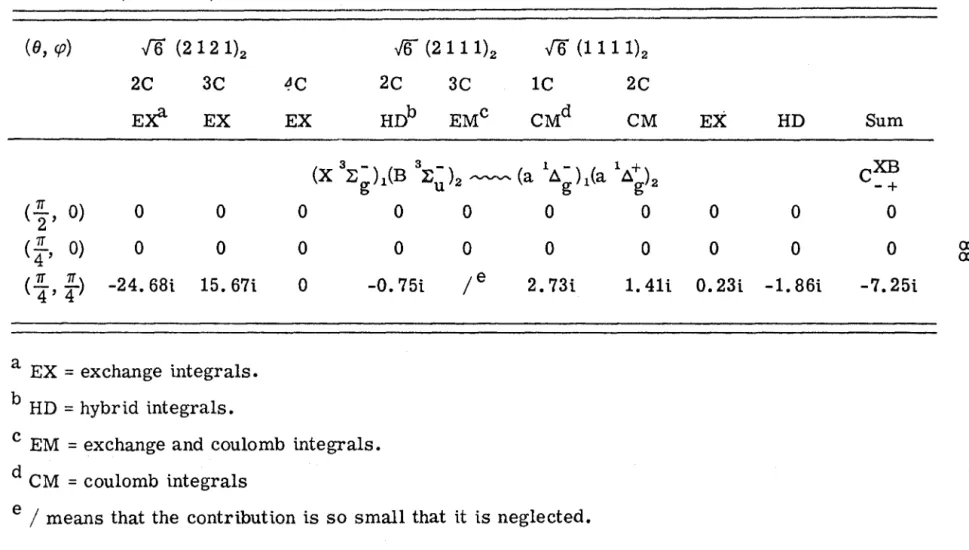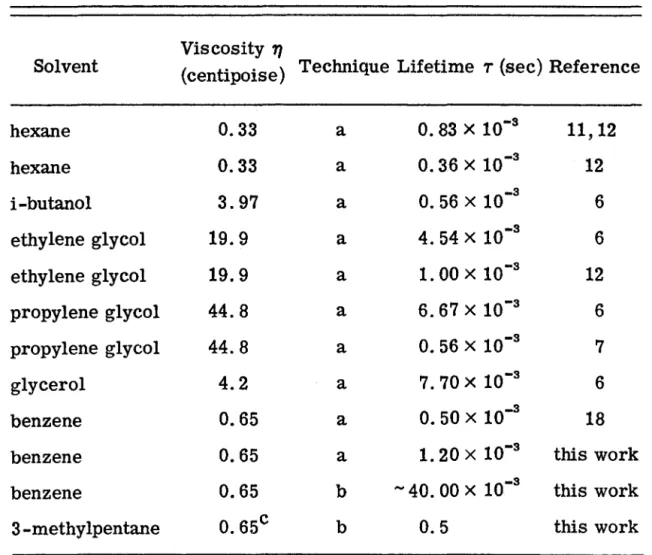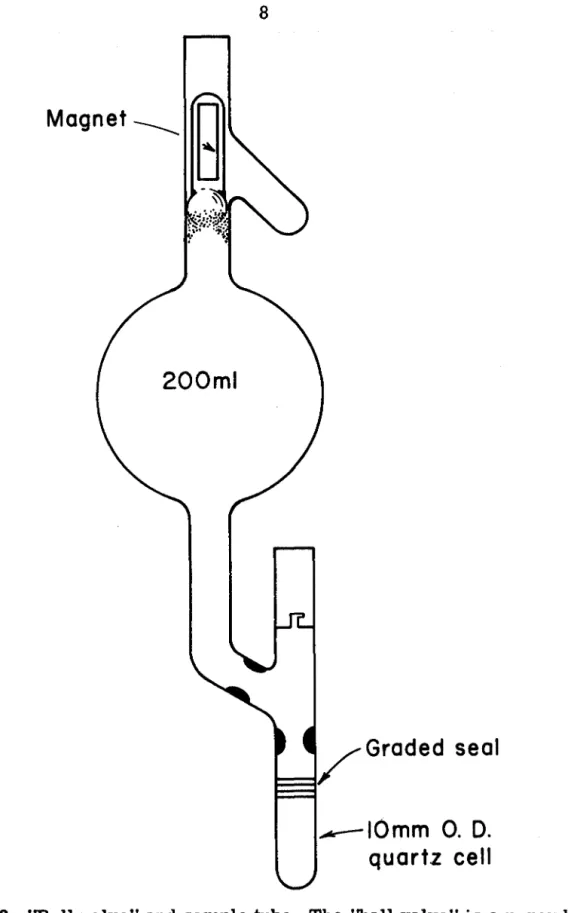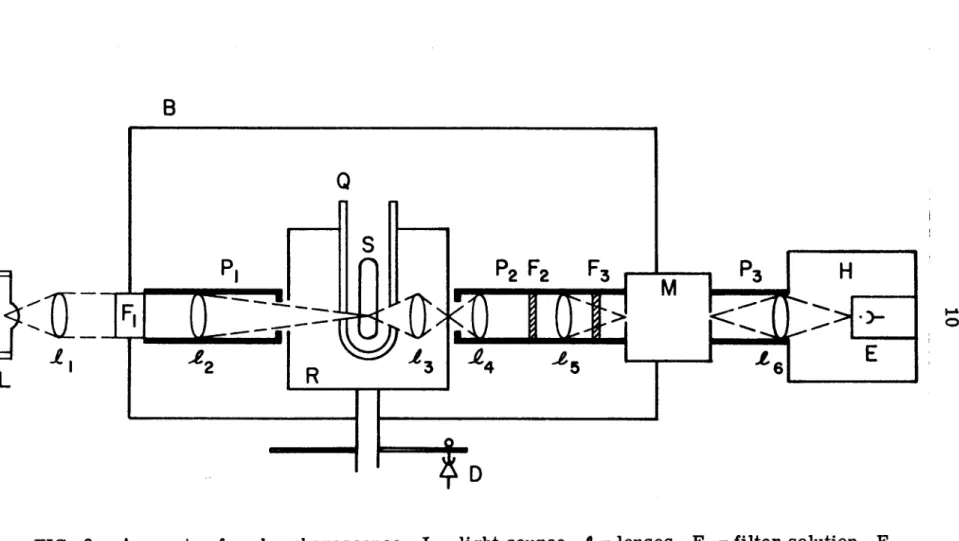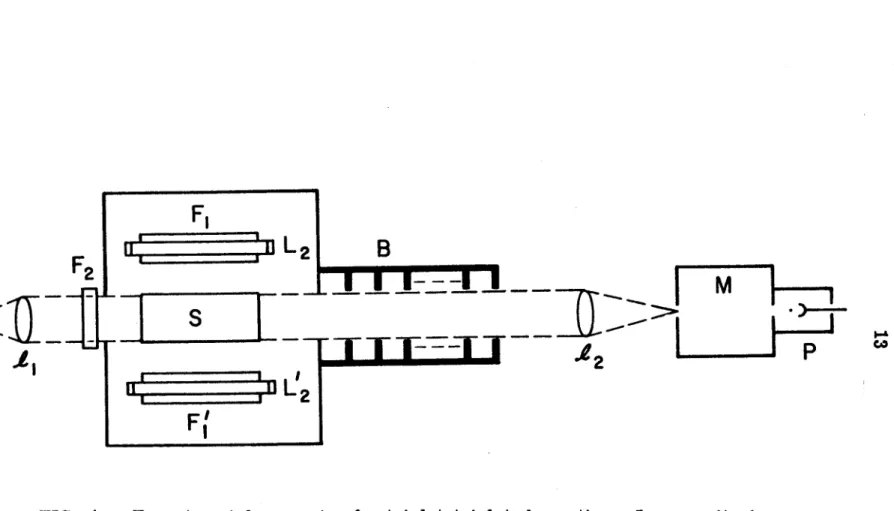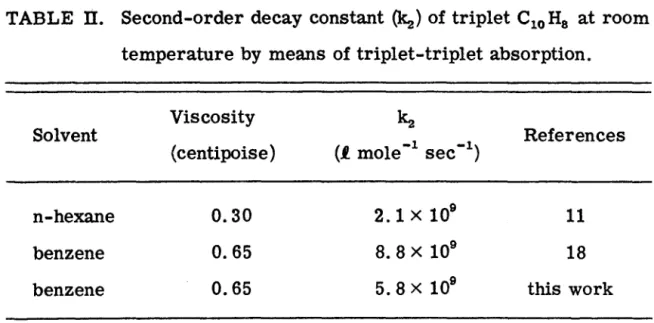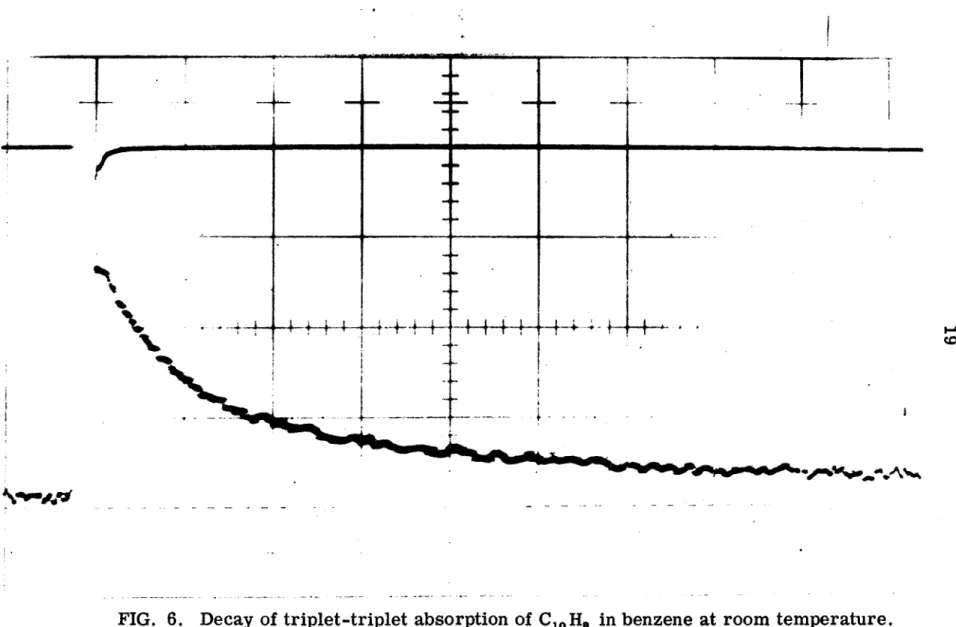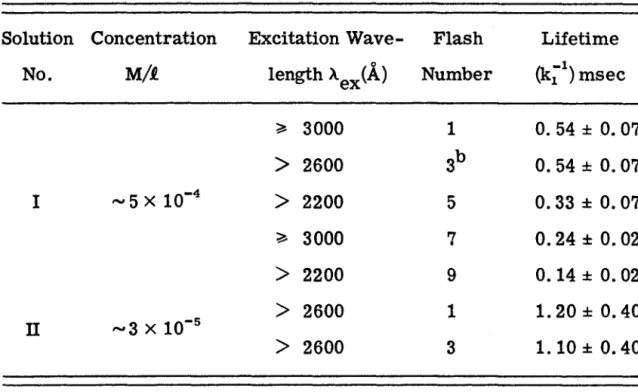Therefore, it appears that the radiative decay times of the lowest triplet states of simple aromatic hydrocarbons in liquid solutions are reasonably the same as those in the solid phase. A small dependence of the phosphorescence lifetime on solvent viscosity was observed in the temperature range -60°. This has been attributed to the diffusion-controlled quenching of the triplet state by residual impurity, perhaps oxygen.
Bimolecular depopulation of the triplet state was found to be of major importance over much of the triplet decay. The effect of temperature and viscosity on the lifetime of the lowest triplet state of naphthalene has previously been investigated in both solid(3, 4) and liquid solutions. The observed temperature or viscosity dependence of the lifetime of triplet states can be attributed to pseudo-first-order decay controlled by diffusion.
The experimental results confirm the idea that the dominant part of "liquid quenching" of the lowest.

EXPERIMENTAL
Therefore, the details of sample preparation are described in this subsection. Benzene was chosen because it can be easily brought to a high degree of purity. l 5) Viscosity of three solvents is shown in the figure. A schematic diagram of the experimental setup used for naphthalene phosphorescence decay measurements is shown in Fig.
The decay curve of the phosphorescence, with a reasonably good signal-to-noise ratio can be obtained by time averaging over 10 K to 100 K counts. A wide range of temperatures in the experiment could be achieved by cooling the sample with nitrogen gas flowing through a copper coil immersed in a liquid nitrogen bath. l 7) The temperature of the sample, placed in the center of the quartz Dewar, is measured by a calibrated copper-constantan thermocouple. The temperature can be maintained to within ± 1 °C for the duration of the experiment by adjusting the flow rate of the nitrogen gas.
The decay of the absorbed light is measured with an RCA 1P28 photomultiplier and a Tektronix oscilloscope; it was photographed in Polaroid-Land.
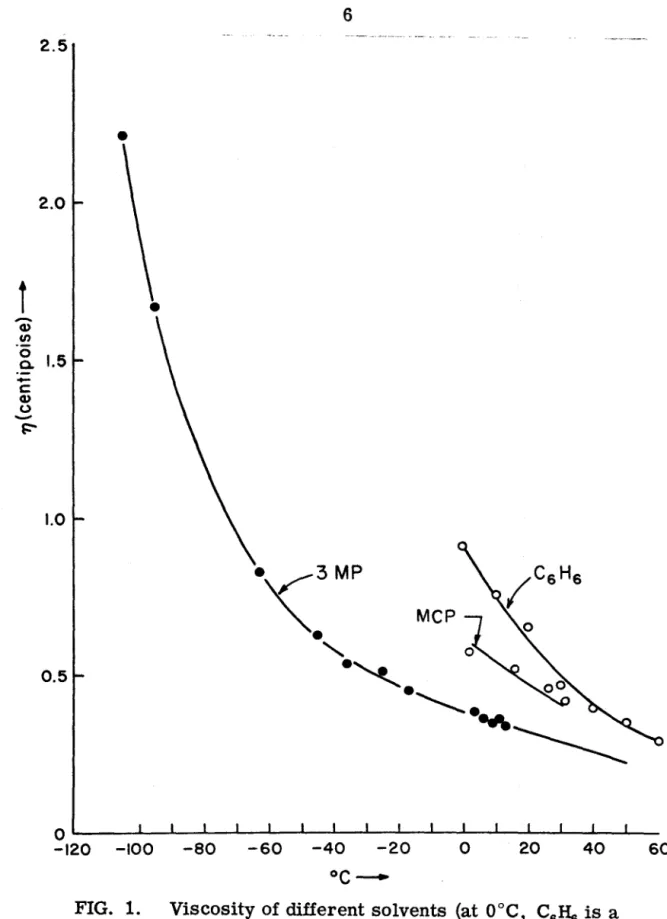
RESULTS AND DISCUSSION
Consequently, the lifetime of the triplet state can be obtained from a graph of log IP or log At vs t. In the absence of the continuous control light, no emission is observed except the stray light from the pulse of flash lamps, as shown in the upper trace of figure. Due to the high sensitivity of the time-averaging technique for measuring phosphorescence decay curves, a number of precautions were taken to ensure that it was indeed the phosphorescence of naphthalene that was being detected.
Experiments with an empty sample tube and a sample tube filled with pure solvent showed only a baseline signal when the monochromator was set to 4700 A (the position of the first intense peak in the C10H8 phosphorescence spectrum - see Figure 1). 7). One small section of the time scale is 4. Semi-log plot of phosphorescent decay of C10H8 in 3-MP at -48 °C and -18 °C. Little or no effect of deuterium on the lifetime of the triplet state of perdeuteronaphthalene in liquid solutions with residual impurities is expected. l 9) Only in the purest solutions, where the lifetime is intrinsic, would a large deuterium effect be observed.
In highly purified solutions, the bimolecular process is so effective compared to the first-order decay process that, as one tries to approach the limit where the first-order process dominates, the concentration of the triplet state becomes too low to measure is through means of single-flash triplet-triplet absorption.
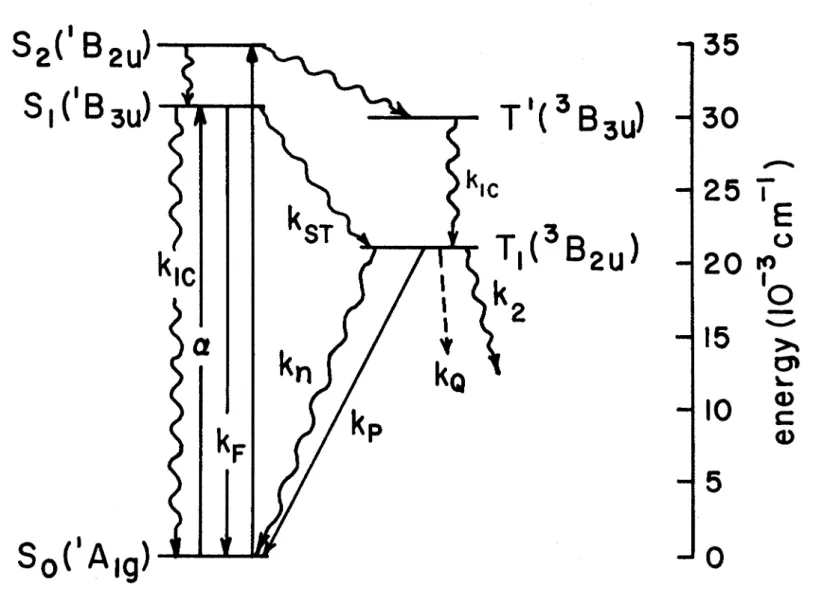
C10Ha, T=0.49±0.07sec
THEORETICAL
Theories of radiationless electronic relaxation have been discussed by Robinson and Frosch, (l) M. 4) These theories have the following in common: the zero-order state of an electronically excited but unexcited molecule is mixed with a state in which the molecule is not electronically - is excited and vibrating; these zero-order states are non-stationary in the presence of a disturbance; It is believed that coupling between the molecule and its environment is necessary to dissipate the vibrational energy and to ensure energy conservation by requiring that the energy spectrum of the coupled system be nearly continuous. They considered the zero-order states of the coupled system to be almost, but not quite, stationary. The time evolution of these states is determined by the time-independent perturbations already present in the free molecule, such as intramolecular vibronic coupling and intramolecular spin-orbit coupling.
The environment simply provides a multitude of states that degenerate nearly to the initial state and a sink for vibrational relaxation processes. He assumed that the interaction between the solute molecules and the environment can be represented by a force field, which is set up by lattice vibrations. Lin derived (3) a radiationless transition probability which is primarily a function of electronic matrix elements Ri (ab), vibrational frequency (wi) and the displacement of the normal mode of the two electronic states involved. ab)=
It was therefore concluded that most of the electronic energy would first enter the internal normal nodes and then transfer to the lattice states through vibrational relaxations. For very short times compared to the time scale t R1 ti 13-1, the probability of a transition from t/I' to states very close to resonance is given by. while for states far from resonance, one has r. Assume that in an idealized case there is a single final state ti/'. n i near resonance with the initial state t/I~. Let/I~ and t/I~ be mixed through the matrix element /3n.
For simplicity, we assume that all matrix elements that directly mix these final states are equal. The figure shows how the directly coupled final state ~~ interacts weakly with the initial state 1/1~, but strongly with a set of indirectly coupled final states~~' ~l1·,. When there are many lattice modes, there can be several final states that have the same molecular vibrational energy as ~~.
The parameter a used in the text of the paper represents an average over all these final states. This figure schematically represents the coupling between the initial state and the final state band.
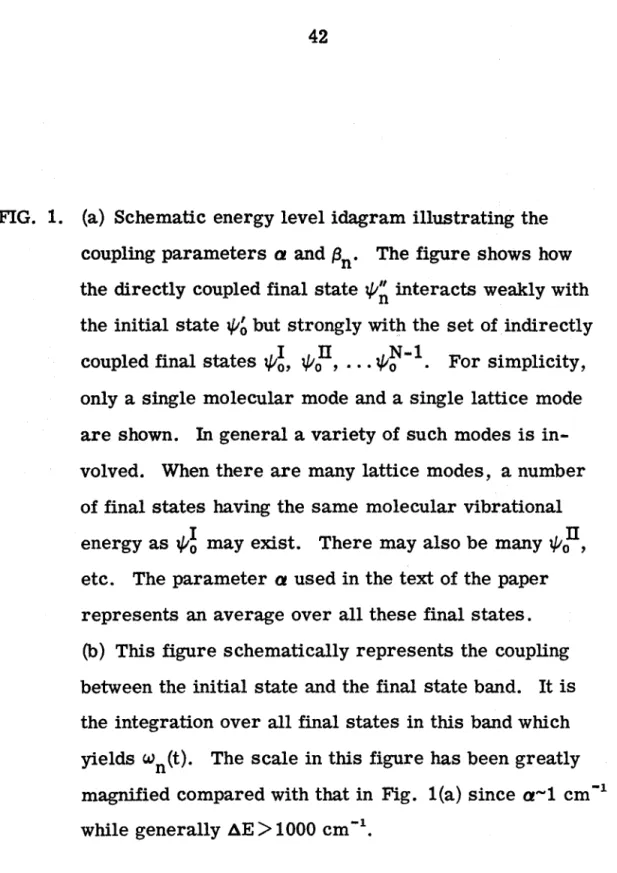
ZERO-ORDER STATES
FINAL REMARKS
According to the ideas presented by Robinson and Frosch, (l) there would be no mechanism by which the non-radiative lifetime of an electronic state could be changed by environmental perturbations of magnitude kT « .6.E, where .6.E is the amount of electronic energy to be given to the environment. Environmental disturbance affecting the non-radiative loss of electronic energy in a molecule can occur: (i) for temperatures where kT ,.., .6.E; (ii) for very high pressure<29) (> 7 Kbar), where a change in the relative position of the potential surfaces of the initial and final states can lead to an increase of the vibrational overlap integrals;<3o ) (iii) when the solvent provides a specific disorder greater than the mixing conditions in the free molecule. e.g. external heavy atom effect); or (iv) when there are solvent-solute interactions strong enough to change the essential character. For the solvent-solvated systems used here, none of these special situations are expected to exist, so no environmental effect on the radiative transition would be expected.
WHY IS CONDENSED OXYGEN BLUE?
- INTRODUCTION
- THEORY
- CALCULATION
- CONCLUSION
It is assumed that the state wavefunctions of the pair system can be represented as antisymmetrized products of one-electron molecular orbitals (MOs). The orthonormal MOs of one molecule are not necessarily orthogonal to those of the other molecule. The spin functions of the lO singlet components are triplet+triplet and singlet+singlet respectively.
The last column in Table III is the root mean of the matrix elements over all orientations, which is defined by. The calculation of the intensity enhancement of the double transition aa - XX can be divided into two parts in the framework of the Born-Oppenheimer approximation: (1) electronic matrix elements of the intermolecular exchange interaction between the disturbed and the disruptive states, and (2) the Franck-Condon factor, which is approximately one for the (0, 0) band. The error is in the right direction, given the nature of the B 3~~ orbitals used.
This mechanism can be justified by studying the photolysis of CH4 + NH3 and CH4 at different excitation wavelengths. The intersystem transition 81 ~ kIC T1 may be important due to the heavy atom effect or a paramagnetic environment2 in the photo-. The quantum yields for photosynthesis in the absence (¢ps 1 ) and presence (¢~:) of triplet energy transfer are given by, respectively. where [T 1] is the concentration of the triplet state.
Reinvestigation of the previous experiment 4 on Friedel-Craft acylation 4 leads to the conclusion that the failure of. At high pressures, the red shift of the m:::cited states and the change in the relative position of the two potential surfaces results in an increase in vibrations. It is the contribution of neighboring atoms to the force field in which the chromophoric electron moves that is responsible for the optical activity.
The corresponding electric and magnetic dipole operators are the sum spanning all the electrons in the molecule, r. angular momentum rotation of. In the absorption range, not only optical rotation but also elliptical polarization of the original linearly polarized light occurs. To verify the polarization theory, it is proposed to measure the optical rotational dispersion (ORD) or optical rotation of a single crystal of naphthalene in the range of Davydov separations.
The resolution of the ORD spectrum can be better than that of the ordinary absorption due to the opposite signs for the two.
